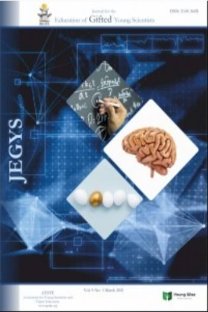Play as a Manifestation of Children’s Imagination and Creativity
This theoretical paper sheds light on the interrelatedness between play, imagination, and creativity, and the importance of realizing this interrelatedness in early childhood education. Based on a thoughtful review of relevant literature, I suggest that children’s play manifests and prompts their imagination and creativity. In addition, I argue that play is a fundamental element in teaching and learning that has the potential to change the classroom environment into an expansive and creative environment. In that space, we can see a real educative play that can “engage, intrigue, interest, puzzle, and enchant” (Jardine et al, 2003, p. 22). Imagination, play, and creativity are necessarily interrelated and interwoven as one fabric; they complete and prompt each other, and together they support learning, opening the door to the possible and the not-yet experienced.
Keywords:
play, creativity, imagination, possibility thinking little c creativity,
___
- Aljarrah, A. (2016). Creativity in classroom settings: Multiple paths are the rule, not the exception. Papers on Postsecondary Learning and Teaching: Proceedings of the University of Calgary Conference on Postsecondary Learning and Teaching, 1, 20-26.
- Aoki, T. T. (2004). Inspiriting the curriculum. In W. Pinar & R. Irwin (Ed.), Curriculum in a new key: The collected works of Ted T. Aoki (pp. 357-365). Mahwah, New Jersey: Lawrence Erlbaum Associates, Publishers.
- Burnard, P., & White, J. (2008). Creativity and performativity: Counterpoints in British and Australian education. British Educational Research Journal, 34 (5), 667- 682.
- Craft, A. (2000). Creativity across the primary curriculum. London: Routledge.
- Craft, A. (2002). Creativity and early years education: A lifewide foundation. London: Continuum.
- Craft, A. (2003). Creativity thinking in the early years of education. Early Years: An International Research Journal, 23(2), 143-154.Davis, B. (1996). Teaching mathematics: Toward a sound alternative. New York: Garland Publishing, Inc.
- Davis, B., Sumara, D., & Luce-Kapler, R. (2008). Engaging minds: Changing teaching in complex times (2nd ed.). New York: Routledge.
- Dewey, J. (1902). The child and the curriculum including, the school and society. New York: Cosimo, Inc. (2008).
- Dewey, J. (2013). My pedagogic creed. In Flinders, D. J. & Thornton, S. J. (Eds.). The curriculum studies reader, 4th Ed. (pp. 33-40). New York: Routledge.
- Froebel, F. (1826/1887). The education of man. New York and London: D. Appleton and Company.
- Gadamer, H. (2004). Truth and method. New York: Continuum Publishing Group.
- Gordon, G. (2008). What is play? In search of a universal definition. Play and Culture Studies, 8, 1-21.
- Gordon, G., & Swimme, B. (2003). The evolutionary power of play: Gwen Gordon and Brian Swimme in dialogue with K. Lauren de Boer. EARTHLIGHT 13, no. 3, 12-18.
- Greene, M. (1995). Releasing the imagination: Essays on education, the arts, and social change. San Francisco: Jossey-Bass Publishers.
- Hall, G. S. (1906). Youth: Its education, regimen and hygiene. New York: Appleton.
- Huebner, D. E. (1967). Curriculum as concern for man’s temporality. In V. Hills (1999). The lure of the transcendent (pp. 131-142). New Jersey: Lawrence Erlbaum Associates.
- Huizinga, J. (1955). Homo Ludens: A study of the play element in culture. Boston: The Beacon Press.
- Jardine, D. (1988). Play and hermeneutics: An exploration of the bi-polarities of mutual understanding. Journal of Curriculum Theorizing, 8(2), 23-41.
- Jardine, D., Clifford, P., & Friesen. S. (2003). Back to basics of teaching and learning: Thinking the world together. Mahwah, New Jersey: Lawrence Erlbaum Associates, Inc, Publishers.
- Jardine, D., Friesen. S., & Clifford, P. (2006). Curriculum in abundance. Mahwah, New Jersey: Lawrence Erlbaum Associates, Publishers.
- Kenny, R. M. (2008). The whole is greater: Reflective practice, human development, and fields of consciousness and collaborative creativity. World Future: The Journal of New Paradigm Research, 64(8), 590-630.
- Millar, S. (1968). The psychology of play. London: Cox and Wyman.
- Norris, J. (2012). Steppingstones to appreciating the importance of play in the creative act. Learning landscapes, 6 (1), 299-314.
- Piaget, J. (1963/2001). The psychology of intelligence. New York: Routledge.
- Rodriguez, H. (2006). The playful and the serious: An approximation to Huizinga’s Homo Ludens. Game studies: The International Journal of Computer Game Research, 6, (1). Accessed September 5, 2015. http://gamestudies.org/0601/articles/rodriges
- Sawyer, R. K. (Ed.). (2011). What makes good teachers great? The artful balance of structure and improvisation. Structure and improvisation in creative teaching (pp. 1-24). New York: Cambridge University Press.Seath, J. D. R. (November, 2007). Etymology of play. playworkings. Retrieved from https://playworkings.wordpress.com/play-connectivity/etymology-of-play/
- Seidel, J., & Jardine, D. W. (2014). Ecological pedagogy, Buddhist, pedagogy, hermeneutic pedagogy: Experiments in a curriculum for miracles. New York: Peter Lang Publishing Group.
- Swimme, B. (1984). The universe is a green dragon: A cosmic creating story. Santa Fe, NM: Bear and Company. Tsai, K. C. (2012). Play, imagination, and creativity: A brief literature review. Journal of Education and Learning, 1, (2), 15-20.
- Vygotsky, L. S. (1967). Play and its role in the mental development of the child. Soviet Psychology, 5, (3), 6-18.
- Başlangıç: 2013
- Yayıncı: Genç Bilge Yayıncılık
